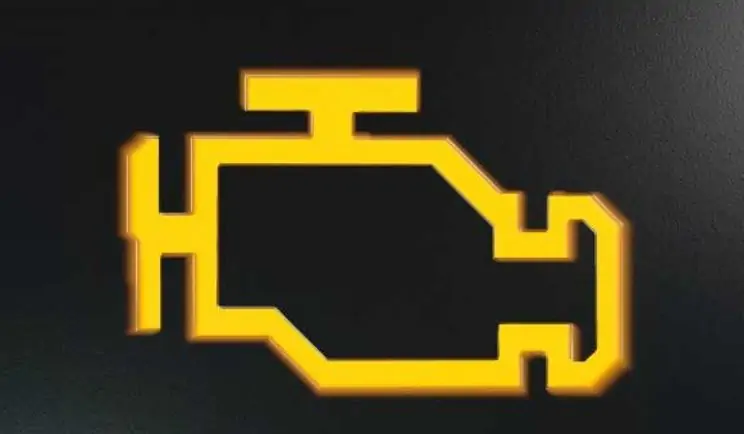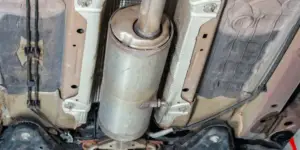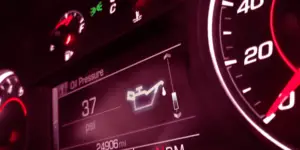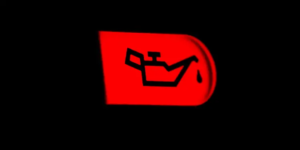When the ECU finds a problem with the engine, it illuminates a yellow, amber, or orange horizontal block with a fan blade on top and its left side. Often it’ll display a warning such as “Check Engine” or Powertrain Fault.”

Can you drive while the check engine light is on?
The light could have been triggered by one or more issues with your car and whether you can drive depends on these three factors.
1. Are there any other warning lights on?
Your dashboard could also indicate low oil pressure or excessive heat. It could show a fault with the ABS. These lights may come on simultaneously as the engine warning light or soon after the engine light comes on.
A red check engine light may illuminate on some car makes to warn you to stop immediately.
Is your car driving differently? Is it making strange noises, or is smoke or water leaking from it?
If so, stop immediately, as you may be causing expensive damage to your car by continuing to drive it.
2. Drive with caution
Reduce your speed and ease off the engine. Avoid accelerating hard or erratic shifting. You may find your car goes into limp mode, where the ECU automatically reduces the available power from the engine to protect itself from further damage. If this doesn’t happen automatically, you should drive more conservatively anyway.
3. Get The Fault Code Read
All modern cars attribute car faults to specific codes. These codes are stored in the ECU of vehicles and can be read by an OBDII machine that plugs into your car and displays the faults on its display.
All mechanics have these code readers, but you can buy one if you don’t want to visit a mechanic for a diagnosis.
A mechanic will charge around $100 to perform a quick diagnostic check. You can buy your own code reader for about $30.
Most ODBII readers will clear the codes, but this won’t alleviate the problem causing the code in the first place. Once removed, the engine warning light will come on again after a few miles if the problem hasn’t been rectified.
What is the maximum time I can drive my car while the check engine light is on?
Some faults causing the engine light to come on are so minor you could drive long distances safely. However, some require fast repairs to stop long-term damage to your engine.
Is your car overheating? 12 quick checks that could save your engine
Is it safe to drive my car while the engine light is on?
Most of the time, it is, but you’ll never know for sure. Cars will normally not be drivable if there is a risk to drivers and passengers. This doesn’t mean you won’t be damaging your vehicle significantly by driving with the light on.
What does a flashing check engine light mean?
A flashing engine check lamp indicates a severe and significant mechanical fault.
To avoid serious damage, it is best to stop the car and call a mechanic immediately.
Why does the engine warning light flash on and off so often?
When you start your car, it checks to ensure it can be safely driven.
Sensors from all over your car send information back to the ECU (car computer), which checks that the readings it receives are within its set boundaries.
It’s possible that some of the readings are borderline and can cause the engine warning light to flicker. This can also happen when you are driving too.
Can the engine check light be reset?
It will need an OBDII handheld machine to clear your car codes effectively. Once done, the engine warning light will not come on immediately.
The bad news is that once the ECU receives information from the sensors that there is still a problem, it will come back on again. The only accurate way of stopping the light from coming back on is to fix the underlying problem.
What Can Cause A Check Engine Light To Come On?
Here we explain the common faults that have made your engine light come on, the costs of repairing or replacing the faulty part, and how much damage they can cause to your engine.
1. A Faulty Oxygen Sensor
Unlikely to Cause Long Term Damage
The oxygen sensor is also known as the O2 sensor. It’s located in the exhaust system of a car and measures the amount of O2 leaving the exhaust.
If it notices a higher than usual reading, it may trigger the engine warning light to come on. A high oxygen reading in the exhaust could indicate a problem with the engine not burning fuel effectively. You may have noticed your car not being as responsive before this happens.
The cost of the replacement is generally $70 plus labor of another $100.
2. A EGR Valve Failure
Unlikely to Cause Long Term Damage
This device can divert up to 15% of the exhaust gas back into your engine, where it will be burned again. This improves fuel efficiency and prevents harmful gases from being released into the atmosphere.
The EGR can get clogged with carbon deposits and become stuck. This can cause rough idle, misfiring, and even difficulty starting. A sensor will alert the ECU, which may activate the engine warning lamp.
An EGR valve costs between $150 – $300 and labor costs of $75 -$100, depending on the make and model of the car.
EGRs can be cleaned. Many mechanics will come to you and offer this service. It costs about $150 and, if successful, is much cheaper than a new EGR valve.
3. Blocked Fuel Injectors
Medium-sized risk of damage to your engine
Fuel injectors do exactly what the name implies. They inject fuel into the engine. The ECU determines the exact point at which the fuel injectors inject the fuel. There is one fuel injector per cylinder.
They can get clogged by fuel particles, which can cause them to fail or be misaligned by other problems in the system. This can cause engine problems, such as misfiring and a decrease in performance.
This is why the fuel filter must be replaced per the manufacturer’s guidelines.
This can be an expensive fix, but it’s always best to try and clean them first. The cleaning solution costs about $10-$15.
If this doesn’t work, a new set of fuel injectors, including labor, costs around $1000.

4. Blocked Fuel Pump
Medium-sized risk of damage
If a fuel pump fails, the engine is starved of the gas it needs to mix with the oxygen. This causes problems with fuel delivery, and the engine can’t work effectively.
The engine warning light will turn on when this occurs, and the car may go into limp mode to reduce the likelihood of damage to the engine.
A new fuel pump cost is expensive. Depending on the make and model of your car, expect to pay between $500 -$1000 for the part and an additional $200 – $400 for labor.
Do you suspect your car has been burning more oil than normal?
Check out our Guide To Car Excess Oil Burning – Why Early Action Can Save Your Engine
5. Bad Air Flow Sensor
Low Risk of Damage To Your Engine
The mass airflow sensor measures how much oxygen is coming into the engine.
If it breaks, it may give a false reading to the ECU notifying it that more or less air is being allowed in than is needed by the engine. This will illuminate the engine warning light as a precaution. Depending on the sensor’s reading, you may notice that your car is also running sluggish or idling high.
The replacement cost ranges from $150 to $400 depending on whether the parts used are genuine or after-market replacements.
6. Leaky Vacuum Tubes
Low Risk of Damage To Your Car
The engine runs efficiently thanks to vacuum hoses that channel air and exhaust around your car’s systems. Rubber hoses are exposed to extreme temperatures and can crack or become brittle, disrupting the delicate balance of gases.
Sensors that detect this variation report it back to the ECU. This triggers the engine warning lamp if the reading exceeds the car’s predefined acceptable limits.
This is a nice cheap fix.
Expect to pay around $70 for diagnosis, parts, and fitting.
7. Clogged Catalytic Converter
High risk of damage
The catalytic convert cleans up the car’s exhaust emissions, but they only have a life span of around 70,000. Once they fail, they can become clogged and stop the exhaust system from working correctly. If your car can’t expel the gases out of your exhaust, the pressure in the engine can increase and cause the engine warning light to come on.
A new catalytic converter is costly due to the rare metals used to reduce harmful emissions. (This is why they get stolen). Cleaning the system can unclog it, but a replacement part is often needed.
The cost of a brand new catalytic converter is generally $1,000-$3,000. Fitting is between $150 and $200.
8. Loose or Cracked Gas Filler Cap
Low Risk of Damage
The simplest and cheapest fix. If your gas filler cap is loose or broken, the pressure drop will be noticed by sensors in the fuel system. This will trigger the engine warning light to come on. If the cap is secure, be sure to check that the cap isn’t cracked, as even a tiny amount of air entering the tank can be noticed by the sensors.
If in doubt, replace the cap before looking at any other causes in this list. It’s a very common issue and a very cheap repair. Expect to pay a few dollars.
In Conclusion
Check engine lights on the dash are always red or amber and show a universal picture of an engine symbol. The symbol may be accompanied by wording such as Check Engine or Powertrain Fault.
Your car may need a tune-up. It improves reliability and also makes it run better. Find out the checks you can do yourself and save $$$.
Read the article here What Does A Car Tune Up Consist of and How To Save Money
Having issues with your ABS light? Discover the 5 Reasons Why Your ABS light is Intermittent and How to Fix it.
If you’ve got an engine light on after going through a puddle it’s time to pull over as you may have a hydrolocked engine and could do serious and expensive damage.












